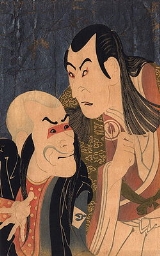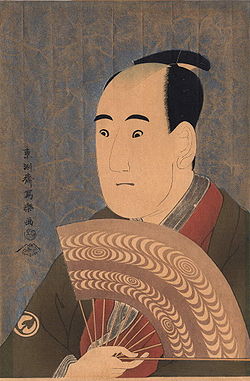
Sharaku
Encyclopedia
is widely considered to be one of the great masters of the woodblock printing in Japan
. Little is known of him, besides his ukiyo-e
prints; neither his true name nor the dates of his birth or death are known with any certainty. His active career as a woodblock artist seems to have spanned just ten months in the mid-Edo period
of Japanese history, from the middle of 1794 to early 1795.

Another speculation associates Sharaku with the great ukiyo-e master Katsushika Hokusai
. This explanation stems from Hokusai's disappearance from the art world between the years of 1792 and 1796, the period that Sharaku's work began to appear. Beyond giving a reason for Hokusai's absence from the Edo art scene during this time the theory has little evidence.
Regarding his abrupt disappearance, one conjecture is that his master was unhappy with his retainer's association with the demimonde of the kabuki
theatre, instead of the more refined Noh
theatre which the master supported. There is no evidence supporting or refuting this.
A headman of Kanda area in Edo named wrote in his supplementary ukiyoe handbook that Sharaku was a Noh actor named . However, as research progressed, the existence itself of Saitō Jūrōbei had become doubtful. A Noh actor, usually of samurai
rank, would have documents proving his origin, the name of Saitō Jūrōbei was not identified in any directory.
Therefore, numerous hypothesis and opinions have come out for a while who Sharaku was, such as an anonymous prominent ukiyo-e painter, or a publisher Tsutaya Jūzaburō
, or if "Sharaku" was the name of a ukiyo-e project by a group of artists, etc.
However in recent years, the existence of a Saitō Jūrōbei was recognized in documents that were discovered in Saitama prefecture
, which lends more credence to the Saitō Jūrōbei hypothesis.
 His career appears to have been so brief in part because the radical nature of his work aroused the hostility of the art world in Edo. One contemporary manuscript records:
His career appears to have been so brief in part because the radical nature of his work aroused the hostility of the art world in Edo. One contemporary manuscript records:
It seems likely that his prints, with their tendency to wring the last drop of truth from his subjects through close depiction of personal characteristics, left customers with a sense of unease, and made his prints difficult to sell. Further, it seems plausible that he was unwilling to compromise his art, and his critics hounded him from the art world.
Indeed, his work did not become popular among collectors in Japan until rediscovered by German scholar Julius Kurth in 1910. He is now considered one of the greatest of all woodblock artists, and the first 'modern' artist of Japan, and the extraordinarily rare extant originals of his prints command fantastic sums at auctions.
This may be in part be because some critics rank him with Rembrandt and Velazquez as one of the world's three greatest portrait painters, and that he is considered the undisputed master of the actor print . His technique of presenting portraits against black or white mica grounds also makes him distinctive due to the striking effects of the mica. This is discussed by Seiichiro Takahashi in his famous "Traditional Woodblock Prints of Japan" which was published as part of The Heibonsha Survey of Japanese Art (Vol.22, pages 98–102 with 7 prints depicted).
Woodblock printing in Japan
Woodblock printing in Japan is a technique best known for its use in the ukiyo-e artistic genre; however, it was also used very widely for printing books in the same period. Woodblock printing had been used in China for centuries to print books, long before the advent of movable type, but was only...
. Little is known of him, besides his ukiyo-e
Ukiyo-e
' is a genre of Japanese woodblock prints and paintings produced between the 17th and the 20th centuries, featuring motifs of landscapes, tales from history, the theatre, and pleasure quarters...
prints; neither his true name nor the dates of his birth or death are known with any certainty. His active career as a woodblock artist seems to have spanned just ten months in the mid-Edo period
Edo period
The , or , is a division of Japanese history which was ruled by the shoguns of the Tokugawa family, running from 1603 to 1868. The political entity of this period was the Tokugawa shogunate....
of Japanese history, from the middle of 1794 to early 1795.

Biography
One theory claims that Sharaku was not a person, but a project launched by a group of artists to help a woodblock print house that had aided them. In this theory, the name Sharaku is taken from sharakusai, "nonsense," and is an inside joke by the artists, who knew that there was no actual Sharaku. The rapidly changing style that Sharaku utilized, with four distinct stylistic changes in his short career, lends credibility to this claim. It was also common for woodblock prints of this time to involve anywhere from five to ten or more artisans working together. However, it seems unlikely that none of them would reveal Sharaku's true identity, or otherwise leave some information about Sharaku behind.Another speculation associates Sharaku with the great ukiyo-e master Katsushika Hokusai
Hokusai
was a Japanese artist, ukiyo-e painter and printmaker of the Edo period. He was influenced by such painters as Sesshu, and other styles of Chinese painting...
. This explanation stems from Hokusai's disappearance from the art world between the years of 1792 and 1796, the period that Sharaku's work began to appear. Beyond giving a reason for Hokusai's absence from the Edo art scene during this time the theory has little evidence.
Regarding his abrupt disappearance, one conjecture is that his master was unhappy with his retainer's association with the demimonde of the kabuki
Kabuki
is classical Japanese dance-drama. Kabuki theatre is known for the stylization of its drama and for the elaborate make-up worn by some of its performers.The individual kanji characters, from left to right, mean sing , dance , and skill...
theatre, instead of the more refined Noh
Noh
, or - derived from the Sino-Japanese word for "skill" or "talent" - is a major form of classical Japanese musical drama that has been performed since the 14th century. Many characters are masked, with men playing male and female roles. Traditionally, a Noh "performance day" lasts all day and...
theatre which the master supported. There is no evidence supporting or refuting this.
A headman of Kanda area in Edo named wrote in his supplementary ukiyoe handbook that Sharaku was a Noh actor named . However, as research progressed, the existence itself of Saitō Jūrōbei had become doubtful. A Noh actor, usually of samurai
Samurai
is the term for the military nobility of pre-industrial Japan. According to translator William Scott Wilson: "In Chinese, the character 侍 was originally a verb meaning to wait upon or accompany a person in the upper ranks of society, and this is also true of the original term in Japanese, saburau...
rank, would have documents proving his origin, the name of Saitō Jūrōbei was not identified in any directory.
Therefore, numerous hypothesis and opinions have come out for a while who Sharaku was, such as an anonymous prominent ukiyo-e painter, or a publisher Tsutaya Jūzaburō
Tsutaya Juzaburo
was the founder and head of the Tsutaya publishing house in Edo period Japan, which produced the ukiyo-e woodblock print works of many of the period's most famous artists, along with illustrated books...
, or if "Sharaku" was the name of a ukiyo-e project by a group of artists, etc.
However in recent years, the existence of a Saitō Jūrōbei was recognized in documents that were discovered in Saitama prefecture
Saitama Prefecture
is a prefecture of Japan located in the Kantō region of the island of Honshu. The capital is the city of Saitama.This prefecture is part of the Greater Tokyo Area, and most of Saitama's cities can be described as suburbs of Tokyo, to which a large amount of residents commute each day.- History...
, which lends more credence to the Saitō Jūrōbei hypothesis.
Retrospective observations

- "Sharaku designed likenesses of Kabuki actors, but because he depicted them too truthfully, his prints did not conform to accepted ideas, and his career was short."
It seems likely that his prints, with their tendency to wring the last drop of truth from his subjects through close depiction of personal characteristics, left customers with a sense of unease, and made his prints difficult to sell. Further, it seems plausible that he was unwilling to compromise his art, and his critics hounded him from the art world.
Indeed, his work did not become popular among collectors in Japan until rediscovered by German scholar Julius Kurth in 1910. He is now considered one of the greatest of all woodblock artists, and the first 'modern' artist of Japan, and the extraordinarily rare extant originals of his prints command fantastic sums at auctions.
This may be in part be because some critics rank him with Rembrandt and Velazquez as one of the world's three greatest portrait painters, and that he is considered the undisputed master of the actor print . His technique of presenting portraits against black or white mica grounds also makes him distinctive due to the striking effects of the mica. This is discussed by Seiichiro Takahashi in his famous "Traditional Woodblock Prints of Japan" which was published as part of The Heibonsha Survey of Japanese Art (Vol.22, pages 98–102 with 7 prints depicted).

